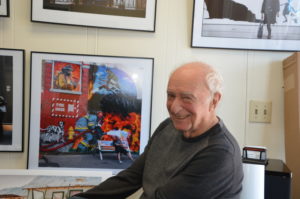Last Week I was sitting in my office and heard a thud.
I turned around to notice that my Nikon camera had fallen from the shelf and landed on the carpet. This is very bad news indeed for a camera owner since dropping an expensive camera is like dropping fine china.
The result would be both depressing and costly. I tried operating the camera but it behaved badly and thus with reluctance and fear in my heart I took it down to Michael Horowitz, owner of A Photographers Place in Williston Park.

Michael has the enviable traits of being both honest and expert. I didn’t say what had happened, acted kind of dumb and said “Michael, my camera seems to be out of whack. Do you think you can take a look and tell me what’s wrong?”
He made a few adjustments to my camera, worked though the labyrinth-like computer programs on the camera’s menu, looked up at me and asked “Hey did by any chance you drop this?”
I blushed and immediately confessed that I did. He then told me to take the trip back to the store form whence I bought the camera and suggested I bring my credit card with me.
But this sad little tale does not end badly for when I was walking out Michael’s store I noticed some truly beautiful photographs on the walls and asked who did those.
Michael said they were to work of Robert Gordon who had just returned from a photo excursion into the Eastern Sierra’s region of California, more commonly known as “Behind the Granite Curtain.”
And what I looked at were stunning photos of untouched land with sheep grazing, mountain ranges soaring into the sky and old prairie homes.
I asked Michael if I could interview this photographer and he said “Well, why not ask him yourself, he just walked in.”
After sitting with him for a while this is what I learned about Robert Gordon.
Bob was born in Brooklyn and raised in Flushing, Queens, along with his brother David. Bob took up photography in high school but married young and worked at Mayer Malbin Company which he now runs.
It was not until years later that he obtained formal training in photography at the New School for Social Research with faculty like Martha Graham, Frank Lloyd Wright and Aaron Copland.
I asked him to describe his process of shooting and he responded “I’m an emotional photographer.
I see the image and take it on the spot. I am always looking so I think I see more than most do. And when I see a good shot I don’t hesitate.”
He then showed me a large photo he took of a European cathedral on a rainy day as a group of tourists walked across the plaza in single file.
This reminded me of that ephemeral “decisive moment” made so famous by Henri Cartier-Bresson. To get magical photos you need to be in the right place at the right time with a camera in hand.
His photography subjects include landscapes like the eastern Sierras, people in galleries looking at art work, and geometric studies of things like doors, windows and walls.
I was reminded of what I learned at the photography show at the Nassau County Museum of Art last year which showed the top one hundred photos on the last century.
The docent described each small black and white photo by photo which included work by Anselm Adams ( Yosemite Park), Dorothea Lange (depression era), Edward Weston and Cartier-Bresson and I suddenly realized that truly great photos reflect our history, are taken at the decisive moment and also have a geometric aesthetic to them.
So the question I asked myself was do Robert Gordon’s photos show us our history, are they taken at the decisive moment and do they contain interesting geometry?
When visiting MoMA Gordon took a photo of one of their most important works entitled “Gone: An Historical Romance of a Civil War As it Occurred b’tween the Dusky Thighs of a Young Negress and Her Heart” by Kara Walker.
The painting is a large black and white canvas, displaying the sexual abuse that black women suffered during the Civil War and as Gordon took the shot a stunning Chinese woman dressed in black walked across the floor at just the right moment and divided the photo in half.
This photo has history, interesting geometry and the decisive moment. In other words Gordon is a master photographer. Following my interview with him I asked his mentor Michael Horowitz to describe Gordon’s talent and he quickly said to me “He is indefatigable. He’s like an iron man. He’s 89 years old, he runs a huge business and yet finds time to travel all over the world taking photos that ought to be put in museums.”
So if you want to see world class photos on display right here on Long Island make you way down to A Photographers Place at 487 Willis Avenue in Williston Park and take a look at how photographs ought to be taken.
And you won’t have to deal with the Midtown Tunnel to see them.
I guess I’m lucky after all that my camera fell off that shelf. How else would I have ever discovered the work of Robert Gordon?



